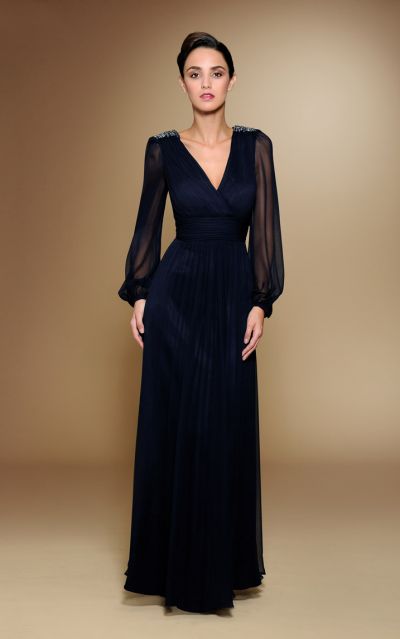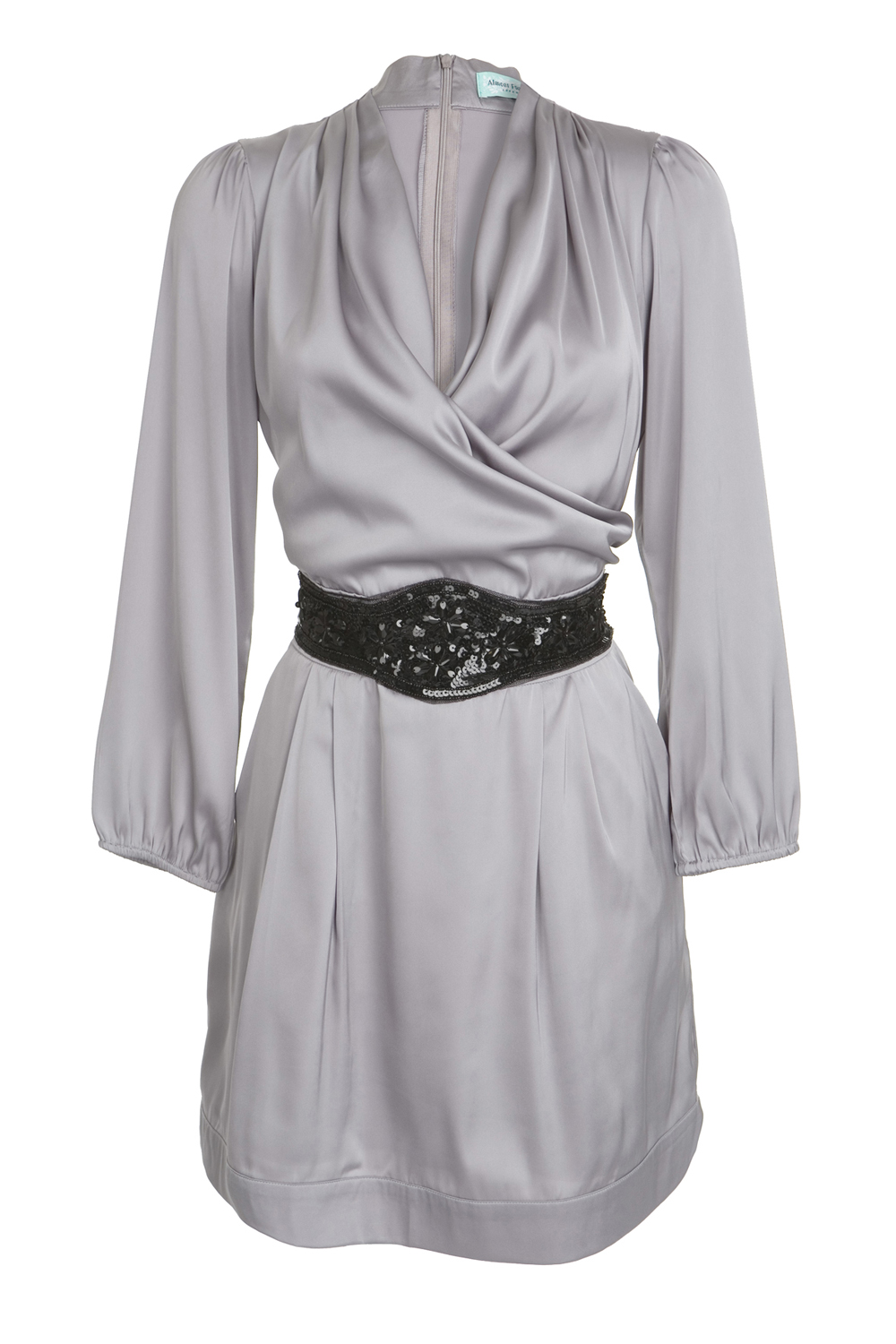Long Sleeve Silk Dress Biography
Source(google.com.pk)
In the early 1930’s sleeves were usually long and slim, even for juniors dresses. In 1931 and 1932 larger puff sleeves began to appear on the runways in Paris and by 1934 day dresses with short shoulder-widening puff sleeves, which became a hallmark of the decade, were what all the popular fashions boasted.
A variety of 1930s afternoon dress sleeves were employed to create the effect of wider shoulders, mostly variations of puff sleeves with generous gathers at the shoulder seam. “Capelet” sleeves that looked almost like a little cape when the wearer bent her elbows, a less full “flaring” sleeve and ruffle “butterfly” sleeves, even pleated sleeves were among the other varieties.
Most sleeves on misses and juniors dresses were short, ending at the elbow, in the mid forearm, or higher. 1930’s day dresses for cooler weather often came with a matching jacket with long sleeves. Dresses for mature and plus-size (called “stout” at the time) women more commonly had long sleeves, along with jackets and coats for all ages. Longer sleeves usually still had generous puffs at the shoulder or at the cuff.
All possible permutations of design have been introduced into sleeve styles over the centuries and these have been revived and reintroduced into fashion according to their suitability for the current mode of dress. Early medieval sleeve designs were generally cut in one with the garment, not set-in. Most usually the sleeve of the outer tunic or gown was cut fully; it could be short, elbow, three-quarter or full-length. If it was not full-length it displayed the wrist length under sleeve which was usually fitting. If it was long it was often very wide and flaring at the wrist, decorated by embroidered banding there and hanging down.
The later Middle Ages, from about 1350 onwards, displayed great variety in sleeve styles, many of which were revived in later periods. In the fourteenth century the tightly-fitting sleeve was fashionable, that of the outer tunic often ending at the elbow in a cuff and hanging tippets, while the under sleeve was decorated by a row of buttons from elbow to wrist and extended to the first row of knuckles on the hand. With the houppelande came the very wide loose sleeve, its edges cut into dagges. Fifteenth-century styles included the bishop sleeve, full and long and gathered into a tight wristband, which had been worn intermittently since sixth century Byzantine dress, the fuller bag or bagpipe sleeve, also fitting at the wrist, and the padded shoulder style. The dolman or batwing sleeve was worn in the early Middle Ages and has reappeared at intervals since. Dolman was generally used to describe the style in the nineteenth century while batwing is a modern term. This is cut very wide at the armhole, almost to the waist, and diminishes towards the wrist; it was most commonly cut in one with the garment. The hanging sleeve appeared in many guises. The thirteenth century version was slit in front at elbow-level and the arm passed through the slit to display the long sleeve of the undergarment. The remainder of the outer, hanging sleeve then fell in folds behind the arm. Fifteenth century versions were often padded in hanging bag sleeves or fell, decoratively pleated, as sleeve capes. Hanging sleeves of the late fifteenth century fell as long tubes nearly to ground level.
The sleeve cut in one with the garment and not set-in was more common in earlier centuries as the set-in sleeve required a higher standard of tailoring to be stylish and comfortable. The kimono style, with a wide Sleeve, was one version (see Japanese dress) and the magyar another. The magyar sleeve stemmed from the Hungarian peasant style and this was usually cut more narrowly at the elbow and widened again towards the wrist.
With the Renaissance an infinite variety of sleeves were introduced which were banded at intervals creating puffs which in turn were padded and slashed to display linings and undergarments. The late fifteenth century Italian finestrella sleeve became fashionable in Europe. This was a fitted design made in two or three parts, the sections being laced together with points and leaving the full puffs of the chemise or shirt to be bloused out between the sections. Puffed sleeves were heavily padded in the men's gowns of the 1530s and 1540s and women's gowns had similarly padded puffs to the upper sleeve and innumerable, jewelled slashes to the lower, with the fabric of the undergarment pulled through the slashes in small puffs. In the 1590s sleeves were padded all the way down but diminishing towards the wrist. Very fashionable was the sleeve banded at intervals all the way down the arm leaving the material to puff out in between. This was a style sometimes called 'virago' and was reintroduced under the French First Empire as a mameluke sleeve.
Especially typical of women's dress in the years 1530-55 was the bell sleeve to the gown displaying a false sleeve beneath. The outer sleeve was fitting on the upper arm and opened out into a wide bell shape. The material was then turned back and fastened to the sleeve of the upper arm so displaying the lining of contrasting colour and fabric. The false sleeve was generally of a third colour and material and was padded, embroidered and jewelled and was slashed to display the white chemise through the slashes. In the 1560s and 1570s an upstanding puff sleeve was fashionable.
With the seventeenth century came simpler designs. In the early years men wore sleeves with epaulet shoulders. With the 1620s and 1630s came the sleeve slashed vertically from shoulder to wrist displaying the white shirt or chemise. By 1635 ladies' sleeves were three-quarter length, very full but unpadded, and were finished by elegant ruffles or lace cuffs.
From the later seventeenth century onwards men's coats were tailored with fitting Set-in Sleeves which widened towards the large cuffs. Women's sleeves were still full and often banded on the upper arm to give a wide open bell sleeve on the forearm. This style was reintroduced as the marino faliero sleeve of the 1830s. Eighteenth century sleeves for ladies' gowns were generally fitting to the elbow where they were finished by a deep cuff or, later, as pagoda or funnel sleeves. These had one or more tiers of flounces sewn to the fitted part at the elbow. Below this sleeve were the silk and lace ruffles called, in French, engageantes. Peasant sleeves were worn in less formal attire, especially in central and eastern Europe; these were very full and had a dropped, gathered shoulder line. The material was gathered in again at the wrists.
Ladies' sleeves of the early nineteenth century were short puff styles or puffed out at the top and long and fitting below. In the 1830s the puff sleeves became much larger developing into the leg-of-mutton (in French gigot) sleeve, a style which was reintroduced in the 1890s. Also fashionable in the 1830s was the elephant sleeve in which the fullness dropped to a lower line resembling an elephant's ear before being gathered into a fitting wristband. The mid-century style was usually wide and flaring at the bottom and only three-quarter or bracelet length. An alternative fashion in the 1890s to the leg-of-mutton sleeve was the balloon or melon style. This was also full at the top and tight on the forearm but was stiffened into a more rounded melon shape and was not gathered in at the shoulder. The raglan sleeve, with its sloping shoulder line, was worn for coats and suits from the mid-nineteenth century (see Coat, Raglan and Rainwear). Fashionable in the twentieth century, in addition to revivals of past styles, were the cap sleeve, just covering the shoulder and the bracelet length sleeve extending to about two inches above the wrist bone.








No comments:
Post a Comment